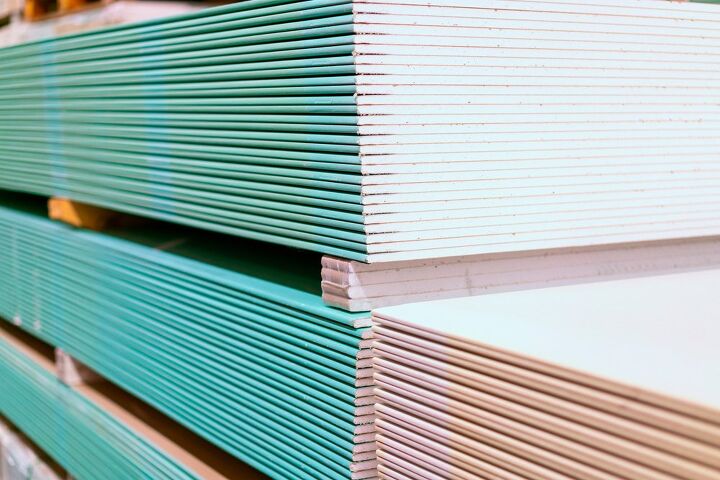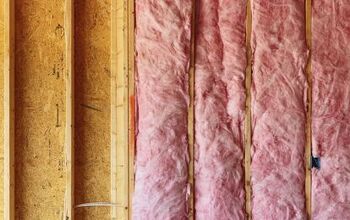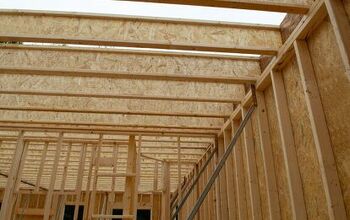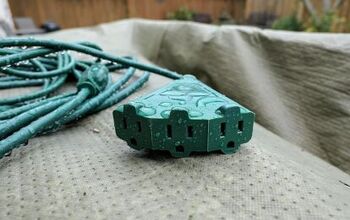Can Drywall Get Wet?

Drywall can be found in the majority of standing structures today. The main ingredient in drywall is gypsum, a non-combustible wall material that’s lighter and cheaper than other popular wall materials, i.e. solid wood and plaster.
Drywall can also be an eye-catching and elegant material, and it insulates well too. Moreover, installing drywall is simple, and so is repairing it.
In North America alone over 20 million ft.² of drywall is manufactured each year—this coming from the Gypsum Association. Since drywall is a staple building material, a builder must understand it inside and out, as without this knowledge they won’t be able to use this material properly.
Is drywall water-resistant? Is wet drywall salvageable? Is it best to keep drywall away from water? Such are the questions this article answers.
Yes, drywall can get wet. However, if it’s exposed to moisture for a prolonged period of time, eventually its structural integrity will be compromised. When this happens, the drywall will become soft and weak, and it’s at this point that mold growth will begin. Since drywall is not water-resistant, you should think twice about using this material in the bathroom.
Do You Need Drywall Repair Services?
Get free, zero-commitment quotes from pro contractors near you.

What Happens When Drywall Gets Wet?
It doesn’t matter if you call it drywall, plaster board, wallboard, or gypsum board—if this material gets wet and stays wet, a variety of negative consequences will be just around the corner. There are many instances in which drywall gets wet unintentionally. For example, if you have drywall in your basement—and this area gets flooded because of a bad storm or a ruptured water heater—the drywall is going to face prolonged water exposure.
Even though drywall is sturdy and solid when not waterlogged, it can become quite weak quite fast when it’s been exposed to water for a prolonged period of time. This is because water breaks down the gypsum compound over time. And once there’s no binding, the material is easily susceptible to crumbling.
Is Drywall Still Usable After It Gets Wet?
Speed is critical when it comes to addressing wet drywall. If one can tackle the problem before it gets too bad, they’ll be able to salvage the drywall.
A general rule is that if you can remove moisture from the drywall before 48 hours pass, then the drywall is salvageable. But if the drywall is still wet 48 hours after it’s first exposed to moisture, the drywall should be removed and replaced. Not only will the structural integrity be compromised at this point—it’s also at this point that mold growth will begin.
But if the drywall has only been exposed to water for an hour or two, you don’t have to worry about it being irreparably compromised on a structural level. But if you are concerned, just run a dehumidifier or a fan near the drywall to accelerate the moisture-removal process.
Should Wet Drywall Be Removed?
Before you go tearing up drywall that’s been exposed to moisture, you must first consider these factors. Once you do, you’ll know what to do with the wet drywall.
First: Assess the extent of the exposure. If a lot of water was involved, then it’s likely you won’t be able to salvage the drywall.
Next: You have to consider time. How long was the drywall exposed to water? The longer exposure is, the harder it’ll be to get the drywall to dry out.
Finally: Do you have the tools necessary to speed up the drying process? Fans, dehumidifiers, and hair dryers can help when natural air drying is not enough to get moisture out of the drywall. These tools are good at drying the exterior of wet drywall, but it’s getting at the moist inner sections that’s challenging.
DIY Wet Drywall Removal vs. Hiring a Professional
If you don’t have the tools and know-how necessary to remove wet drywall on your own, then you should get a professional to handle this for you. Wet drywall can be hazardous when ingested, and breathing in a large amount of drywall dust can be harmful as well. And if mold has already started growing on the wet drywall, contact with this material is even more dangerous.
Don’t put yourself at risk when you don’t need to. A professional will be able to remove wet drywall without taking any of the risks above, as they’ll know what’s needed to remove the drywall properly.
Also, a DIYer won’t have what’s needed to thoroughly clean the space after the wet drywall has been removed, and therefore they won’t be able to replace the drywall easily. Whereas if you hire a professional, they’ll have the space ready for replacement immediately, and they’ll probably do the replacing as well.
Can Wet Drywall Cause Mold?
Mold can grow on wet drywall, especially if the drywall has been exposed to moisture for a prolonged period of time. Here are four things that exacerbate mold growth:
- Moisture
- Starch or sugar
- Oxygen
- Temperature (No lower than 40° and no higher than 100°.)
Indoors, there’s plenty of oxygen. Moreover, the temperature is usually ideal for mold growth. Starch and sugar can both be found in the drywall paper, and mold will feast on this and spread all the while.
Mold can spread undetected and then suddenly become unavoidable, even when you’re certain water exposure didn’t affect the drywall. For this reason, if you know the drywall has been exposed to water, you need to monitor this area routinely to make sure there’s no mold growing.
Does Wet Drywall Dry on Its Own?
Drywall can dry out naturally, but how well it’s able to do so depends on where the drywall is located. If, for example, the drywall is in a damp basement, then it’ll take longer to dry, whereas if it’s in a spot that gets hours of sunlight during the day, it’ll dry quicker.
Again, the elements of exposure and time largely determine how well drywall can dry naturally. Moreover, if the drywall was old and already showing signs of wear and tear when it got wet, it’ll be harder for the drywall to regain its strength and stability.
Can You Sand Wet Drywall?
Up until this point, we’ve focused on drywall that gets exposed to water unintentionally. But is there ever a reason to intentionally get your drywall wet? There is, and it’s known as wet sanding.
For all the reason discussed already, you need to be careful when wet sanding. If you oversaturate the drywall, you won’t smooth the surface out but compromise its structure instead.
When newly installed drywall drys, wet sanding can be done to remove any leftover taping compound. There are special wet sanding sponges out there, and using one of these will help you avoid damaging the drywall.
What Happens to Drywall That’s Next to the Shower?
It’s best to avoid using drywall in the bathroom, as this is an area where moisture is present often. And you certainly don’t want drywall serving as your shower walls, as it’ll break down eventually and create a host of problems. Tile, fiberglass, and natural stone are the materials one should use to encase a shower.
Drywall can be waterproofed, but doing so is regarded as more trouble than it’s worth by many. Plus, one needs to know what they’re doing when waterproofing drywall, as the waterproofing substance can be noxious and even hazardous when handled by inexperienced individuals.
Do You Need Drywall Repair Services?
Get free, zero-commitment quotes from pro contractors near you.

Related Questions
When should a wet drywall ceiling be replaced?
A drywall ceiling is in a particularly vulnerable position, as it can be negatively affected by a leak. And by the time you realize the leak is there, it may be too late to save the drywall. This is why most individuals don’t have drywall ceilings. Plaster is a better option because it’s stronger, stabler, and more water-resistant.
Can one blot drywall with towels?
After you do what you can with fans and dehumidifiers, you can blot a wet drywall with towels. Keep in mind that this is a tedious process that really only affects the exterior part of the wall. Blotting will not affect water that has seeped deep into the wall.

Matt loves everything DIY. He has been learning and practicing different trades since he was a kid, and he's often the first one called when a friend or family member needs a helping hand at home. Matt loves to work with wood and stone, and landscaping is by far his most favorite pastime.
More by Matthew Mountain



























